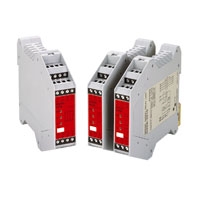| Main
contacts |
Auxiliary
contact |
Number of input channels | Reset mode | Input type | Rated voltage | Model |
|---|---|---|---|---|---|---|
| DPST-NO | None | 2 channels | Auto-reset | Inverse | 24 VAC/VDC | G9SB-2002-A |
| 1 channel or 2 channels | + common | G9SB-200-B | ||||
| 2 channels | Manual reset | Inverse | G9SB-2002-C | |||
| 1 channel or 2 channels | + common | G9SB-200-D | ||||
| 3PST-NO | SPST-NC | None (direct breaking) | Auto-reset | --- | 24 VDC | G9SB-3010 * |
| 2 channels | Inverse | 24 VAC/VDC | G9SB-3012-A | |||
| 1 channel or 2 channels | + common | G9SB-301-B | ||||
| 2 channels | Manual reset | Inverse | G9SB-3012-C | |||
| 1 channel or 2 channels | + common | G9SB-301-D |
Note: 1. Relays with inverse inputs are used mainly when inputting signals from two mechanical switches.
2. Relays with positive commons are used mainly when inputting signals from a safety sensor or from one
mechanical switch.
* The G9SB-3010 can be applied to Safety Category 3 of the EN954-1 if double breaking is used.
2. Relays with positive commons are used mainly when inputting signals from a safety sensor or from one
mechanical switch.
* The G9SB-3010 can be applied to Safety Category 3 of the EN954-1 if double breaking is used.
